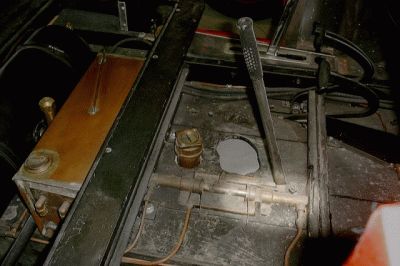
THE HAND WATER PUMP IS LOCATED UNDER THE FRONT SEAT FOOT BOARDS WITH THE REMOVABLE HANDLE PROJECTING THROUGH THE FOOT BOARDS
The water, oil, and fuel pumps on later model Stanley steamers are run from the rear axle of the car. Whenever the car is in motion the pumps are in operation. The hand water pump provides a way to pump water from the main water tank to the boiler. The displacement of the hand water pump is small compared to that of the two power water pumps and thus the functional use of the hand water pump is somewhat limited.
The hand water pump is located under the front floorboards and the water pumpís piston is on a common shaft with the hand fuel pumpís piston. A pump handle connected to the shaft between the pump pistons rises from the floorboards and is rocked back and forth so that both the hand water and fuel pumps operate. A valve on the front power water pump controls if the hand water pump is to pump water or not as the pump arm is moved.
In the event the water gets so low that the low water automatic operates to shut off fuel flow to the main burner it is possible to use to hand water pump to raise the water level of the boiler enough to get the burner relit (this assumes that what caused the low water condition has been fixed). The hand water pump can also be used when traveling up a long hill at slow speed to assist the power water pumps in adding water to the boiler. The worst part of using the hand water pump is that youíre not only pumping against the 140 PSIG pressure of the burner fuel system but youíre pumping against the steam pressure of the boiler.